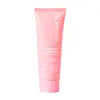What's inside
What's inside
 Key Ingredients
Key Ingredients

 Benefits
Benefits

 Concerns
Concerns

 Ingredients Side-by-side
Ingredients Side-by-side

Water
Skin ConditioningPotassium Laureth Phosphate
EmulsifyingGlycerin
HumectantButylene Glycol
HumectantPotassium Cocoyl Glutamate
Acrylates/C10-30 Alkyl Acrylate Crosspolymer
Emulsion StabilisingPanthenol
Skin ConditioningAspartic Acid
MaskingCaprylyl Glycol
EmollientSodium Cocoyl Glutamate
CleansingAvena Sativa Kernel Extract
Abrasive1,2-Hexanediol
Skin ConditioningLauryl Hydroxysultaine
CleansingGlyceryl Caprylate
EmollientPentylene Glycol
Skin ConditioningMethyl Diisopropyl Propionamide
MaskingDisodium EDTA
Allantoin
Skin ConditioningAnthemis Nobilis Flower Extract
MaskingHydroxyphenyl Propamidobenzoic Acid
Skin ConditioningSalvia Officinalis Leaf Extract
CleansingPolysorbate 80
EmulsifyingGuaiazulene
AntimicrobialAscorbyl Palmitate
AntioxidantWater, Potassium Laureth Phosphate, Glycerin, Butylene Glycol, Potassium Cocoyl Glutamate, Acrylates/C10-30 Alkyl Acrylate Crosspolymer, Panthenol, Aspartic Acid, Caprylyl Glycol, Sodium Cocoyl Glutamate, Avena Sativa Kernel Extract, 1,2-Hexanediol, Lauryl Hydroxysultaine, Glyceryl Caprylate, Pentylene Glycol, Methyl Diisopropyl Propionamide, Disodium EDTA, Allantoin, Anthemis Nobilis Flower Extract, Hydroxyphenyl Propamidobenzoic Acid, Salvia Officinalis Leaf Extract, Polysorbate 80, Guaiazulene, Ascorbyl Palmitate
Water
Skin ConditioningPotassium Laureth Phosphate
EmulsifyingGlycerin
HumectantPotassium Cocoyl Glutamate
Acrylates/C10-30 Alkyl Acrylate Crosspolymer
Emulsion StabilisingButylene Glycol
HumectantCentella Asiatica Leaf Water
Skin ConditioningCaprylic/Capric Triglyceride
MaskingAspartic Acid
MaskingCaprylyl Glycol
EmollientSodium Cocoyl Glutamate
Cleansing1,2-Hexanediol
Skin ConditioningLauryl Hydroxysultaine
CleansingCoco-Glucoside
CleansingPolyglyceryl-10 Laurate
Skin ConditioningPolyglyceryl-10 Myristate
Skin ConditioningGlyceryl Caprylate
EmollientMelaleuca Alternifolia Leaf Oil
AntioxidantSodium Cocoyl Isethionate
CleansingDisodium EDTA
Calendula Officinalis Flower Extract
MaskingMentha Piperita Oil
MaskingQuillaja Saponaria Bark Extract
CleansingArtemisia Capillaris Extract
Water, Potassium Laureth Phosphate, Glycerin, Potassium Cocoyl Glutamate, Acrylates/C10-30 Alkyl Acrylate Crosspolymer, Butylene Glycol, Centella Asiatica Leaf Water, Caprylic/Capric Triglyceride, Aspartic Acid, Caprylyl Glycol, Sodium Cocoyl Glutamate, 1,2-Hexanediol, Lauryl Hydroxysultaine, Coco-Glucoside, Polyglyceryl-10 Laurate, Polyglyceryl-10 Myristate, Glyceryl Caprylate, Melaleuca Alternifolia Leaf Oil, Sodium Cocoyl Isethionate, Disodium EDTA, Calendula Officinalis Flower Extract, Mentha Piperita Oil, Quillaja Saponaria Bark Extract, Artemisia Capillaris Extract
 Reviews
Reviews

Ingredients Explained
These ingredients are found in both products.
Ingredients higher up in an ingredient list are typically present in a larger amount.
1,2-Hexanediol is a synthetic liquid and another multi-functional powerhouse.
It is a:
- Humectant, drawing moisture into the skin
- Emollient, helping to soften skin
- Solvent, dispersing and stabilizing formulas
- Preservative booster, enhancing the antimicrobial activity of other preservatives
Acrylates/C10-30 Alkyl Acrylate Crosspolymer is a synthetic polymer. It is used to thicken and improve the texture of products. Due to its properties, it can prevent water and oil ingredients from separating.
Aspartic Acid is an amino acid that our bodies produce naturally. It is an antioxidant.
Our body uses Aspartic Acid to help build collagen and elastin. It also plays a role in hydrating skin.
Butylene Glycol (or BG) is used within cosmetic products for a few different reasons:
Overall, Butylene Glycol is a safe and well-rounded ingredient that works well with other ingredients.
Though this ingredient works well with most skin types, some people with sensitive skin may experience a reaction such as allergic rashes, closed comedones, or itchiness.
Learn more about Butylene GlycolCaprylyl Glycol is a humectant and emollient, meaning it attracts and preserves moisture.
It is a common ingredient in many products, especially those designed to hydrate skin. The primary benefits are retaining moisture, skin softening, and promoting a healthy skin barrier.
Though Caprylyl Glycol is an alcohol derived from fatty acids, it is not the kind that can dry out skin.
This ingredient is also used as a preservative to extend the life of products. It has slight antimicrobial properties.
Learn more about Caprylyl GlycolDisodium EDTA plays a role in making products more stable by aiding other preservatives.
It is a chelating agent, meaning it neutralizes metal ions that may be found in a product.
Disodium EDTA is a salt of edetic acid and is found to be safe in cosmetic ingredients.
Learn more about Disodium EDTAGlycerin is already naturally found in your skin. It helps moisturize and protect your skin.
A study from 2016 found glycerin to be more effective as a humectant than AHAs and hyaluronic acid.
As a humectant, it helps the skin stay hydrated by pulling moisture to your skin. The low molecular weight of glycerin allows it to pull moisture into the deeper layers of your skin.
Hydrated skin improves your skin barrier; Your skin barrier helps protect against irritants and bacteria.
Glycerin has also been found to have antimicrobial and antiviral properties. Due to these properties, glycerin is often used in wound and burn treatments.
In cosmetics, glycerin is usually derived from plants such as soybean or palm. However, it can also be sourced from animals, such as tallow or animal fat.
This ingredient is organic, colorless, odorless, and non-toxic.
Glycerin is the name for this ingredient in American English. British English uses Glycerol/Glycerine.
Learn more about GlycerinGlyceryl Caprylate comes from glycerin and caprylic acid, a fatty acid from coconut. It has emollient and emulsifier properties.
As an emollient, it helps hydrate your skin. Emollients work by creating a barrier on your skin to trap moisture in, helping to keep your skin soft and smooth.
On the other hand, emulsifiers prevent ingredients (such as oil and water) from separating.
Learn more about Glyceryl CaprylateWe don't have a description for Lauryl Hydroxysultaine yet.
We don't have a description for Potassium Cocoyl Glutamate yet.
We don't have a description for Potassium Laureth Phosphate yet.
Sodium Cocoyl Glutamate is a gentle cleanser and surfactant. It is the sodium salt of the Cocoyl Glutamic Acid and comes from coconut oil. As a surfactant, it helps lift dirt and oil to be washed away.
Sodium Cocoyl Glutamate also has an emolliating effect and can help leave the skin feeling soft.
Water. It's the most common cosmetic ingredient of all. You'll usually see it at the top of ingredient lists, meaning that it makes up the largest part of the product.
So why is it so popular? Water most often acts as a solvent - this means that it helps dissolve other ingredients into the formulation.
You'll also recognize water as that liquid we all need to stay alive. If you see this, drink a glass of water. Stay hydrated!
Learn more about Water